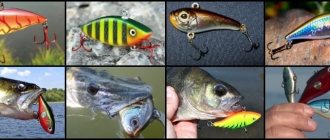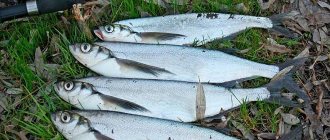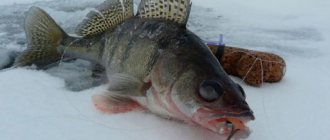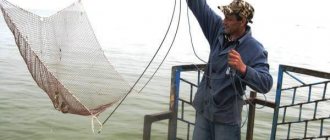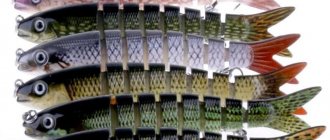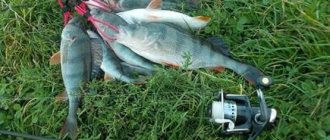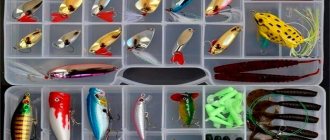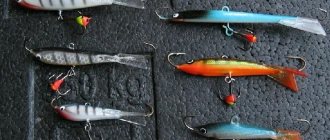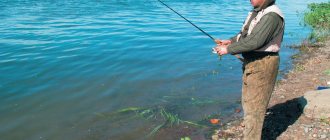A number of spinning lures have long gained their positions in the arsenals of fishermen. At first, few people took minnow-type wobblers seriously, considering them almost a factory defect, since previously their own game was considered mandatory for such baits. A similar situation occurred with edible silicone without active elements such as worms, larvae or slugs. At the moment, rattlins can also be considered a largely underrated type of spinning lure. There are many reasons for this situation - the lack of information, their increased grip, as well as their low similarity with the usual prey of predators (minnows or shads are much more reminiscent of live fish). Therefore, rattlin fishing is not very popular, especially among novice spinning anglers. The bait itself, thanks to the characteristic features of the game, works well on active fish, collecting it from long distances.
Differences from other wobblers
What is rattlin? This is a special type of wobbler, which has characteristic differences from other types of these spinning baits:
- They do not have a shoulder blade. Instead, the relatively large mass and wide back of the bait are responsible for deepening. The absence of a blade provides higher frequency and lower amplitude playing.
- The attachment to the leash or fishing line is located not on the nose, but on the back of the wobbler, which contributes to its special game, as well as maintaining approximately the same depth of wiring.
- Almost all rattlins are sinking baits; unlike other types of wobblers, they usually do not have options with different buoyancy.
- They have a large weight with a relatively small size, which has a positive effect on the flight qualities of the rattlin.
- The body shape is often close to diamond-shaped.
Equipment
The rattlin bait does not require any special equipment; the standard for winter trolling is suitable. The grip on the vibration is strong, the blow is felt by the hand. It is better to use neat tackle, which will allow you to feel the nuances of the wiring with your hand. The fishing line used is 0.2-0.3 mm, depending on the trophies; for pike it is necessary to use a metal leash. The ratlin is attached through a swivel to protect the line from twisting and give the bait free movement. However, if twisting does not occur, it is better to mount the vib on a blind loop, like a balancer. This can be established experimentally on a reservoir. As already mentioned, the game also depends on the weight and size of the installed hooks. You shouldn’t overdo it with placing additional bright elements on them. A small eye or cambric on the first hook won't hurt.
Possible areas of application
The rattlin wobbler has one significant drawback - due to the peculiarity of its shape, negative buoyancy, the location of the hooks and the wiring used, hooks are a common occurrence when using these baits.
Important!
You can reduce the number of snags by simply replacing the hooks. Tees need to be replaced with doubles, placing them with their tips facing up. You can also remove one of the hooks altogether. At first glance, the features of the game and increased grip greatly limit the possible scope of application. However, the list of situations when rattlins can be used effectively is quite large:
- They are well suited for the role of a scout, whose main task is to search for an active predator in an unfamiliar body of water.
- In summer, such wobblers are effective for catching perch in the upper layers. Casting rattlin into autumn perch “cauldrons” should also be successful.
- On reservoirs with a clean bottom, you can catch pike perch using rattlins. To do this, you need to let the wobbler sink to the bottom, and then use a wiring similar to a jig. When catching this fish, it is better to give preference to models with a more elongated body.
- It is also suitable for catching chub under overhanging tree branches or near steep banks. In this case, this sinking wobbler should not be allowed to go deep. Wiring for demolition is suitable, uniform, or wavy closer to the upper layers of water.
- If there are not too snag holes in the reservoir, it is possible to use this bait for fishing for catfish or pike. The best way for this is jigging, in which the rattle regularly touches the bottom.
Hunting for trout
Trout is an absolutely extraordinary predator. They assure that in natural conditions it easily pushes pike out of a comfortable parking lot, including pike that are noticeably larger than it. And at the same time, it can be caught with equal success using spoons and the most diverse natural baits. The perch is also considered an equally “all-round” predator, but the trout is disproportionately larger: catching a one-kilogram humpback salmon in the middle zone is a huge fortune, while a trout weighing more than three kilograms on a platform is a completely ordinary thing.
Of the entire stock of trout baits, the most suitable are spinners. But in terms of catchability, they are in no way inferior to other baits, such as balancers, ratlins, various imitations of insects made from edible gum, not to mention natural baits. Moreover, there are often situations when spinners, for various reasons, do not bring the predicted result; in this case, there is no way to do without other baits. So the trout hunter must have them too.
Blancirs and Ratlins
Ratlins, bladeless, sinking wobblers with a ring for tying fishing line in the front part of the back, have justly become fashionable among those who fish for trout from the ice. Lures are produced by numerous manufacturing companies. At first they were developed as summer baits, and when fishing vertically from the ice, you need to take into account certain subtleties of their game. Thus, ratlins do not like the extensive game that is used when fishing with spoons.
Significantly more successful is the “jig” game with the least vertical movement and light swaying in the absence of sudden movements. Literally the same game is often preferable when fishing on balance beams. It should be noted that if the fisherman does not have a hand positioned in any way, then when fishing with ratlins and balancers using sudden swings and drops of the bait, hooks often overlap with the fishing line. After which you have to pull out the bait, unhook the hook and start all over again.
Trout, regardless of its size, most often like relatively small baits: ballancers 3-6 cm and ratlins 3-5 cm.
As for colors, they need to be selected for certain situations, taking into account the specifics of the reservoir, the weather conditions, mainly lighting, and a number of other points. In order to always be fully armed, the box must certainly contain baits of 3 types of colors: natural colors, acidic ones and painted in red-orange tones. It is very important that lures of these colors are of the same model.
Required Rod and Reel
A spinning rod for using rattlins is preferable to one that is fairly rigid and has a fast action. The wiring of these baits contains twitching and jig elements, which means that the rod should not “fall through” during jerking. The test form should be selected based on the weight of the bait, and, consequently, the size of the expected catch. The length of the rod should be selected based on the fishing distance, the features of the shore, as well as the possibility of fishing using a swimming device. Long distances when fishing from the shore require a spinning rod with a length of 2.4 - 2.7 meters or more, but for a boat, shorter fishing rods 1.8 - 2.1 meters in length would be a more suitable option.
A spinning reel or a multiplier reel is suitable; here it is usually worth focusing on the preferences of a particular angler. Sizes - from 1000 to 4000, depending on the characteristics of the selected fishing rod. There are no increased requirements for the quality of winding thin fishing lines and cords, since they are rarely used.
When fishing with rattlins, both braided and monofilament lines are used, but it should be taken into account that different stretchability can have different effects on the performance of the same bait. But the leashes are most often made of metal, which is necessary not only to prevent the pike from biting the line, but also to prevent the hooks from tangling over the line.
How to catch pike with rattlins
Rattlins are often called universal baits. But fishermen agree that they are not so clear-cut: you need to get used to them, otherwise disappointment cannot be avoided. The selection of bait is carried out based on the fishing depth and its weight.
Techniques and tactics of fishing with rattlin
Even for novice fishermen, catching pike with ratlins is not very difficult. The basic wiring looks like this:
- perform a quick but smooth swing of the rod, placing the bait directly above the bottom, and then lower it to the starting position;
- pause and repeat the jerk.
Until the bite occurs, you should fish at various points. The noise made by the bait and active play can attract pike even from a great distance, so you shouldn’t rush to leave a place that seems fishless at first glance.
The rattlin's movement should not be too sharp. For pike, a more measured, sweeping and impressive action of the bait is preferable. To achieve good results, you need to know how different styles of bait are performed and understand how it behaves under water. Often a pike bite occurs when changing the type of wiring.
With the use of rattlins, a large selection of wiring is available - these include all types known for wobblers. Effective for pike:
- continuous wiring, as well as against strong currents. To do this, you should: throw the bait into the water, reel in the fishing line with a reel, then reel in, evenly rotating the reel handle at a certain speed. If you rotate quickly, the rattlin floats to the surface, if slowly, it explores the deep layers at the bottom. The method is relevant for reconnaissance of pike locations;
- stepwise retrieval with stops until the bait falls to the bottom. It is carried out like this: cast, reel in the slack line, then 3-5 turns of the reel, pause, repeat turns;
- wiring “striking” along the bottom. Rattlin passes through a depth approximately equal to its working value; during the drive, it falls with its nose into the ground, then bounces above it, creating a cloud of turbidity;
- Retrieving from shallows to depth is effective, especially when fishing near a pronounced drop in depth.
About
Color, back width and other features
The choice of wobbler for specific conditions is influenced by the width of the back. For bodies of water with weak or no current, rattlins with a wide back are more suitable, as they require more drag for active play. Narrow options are designed for fishing in current conditions, where you need to maintain the game under the influence of a water flow that disrupts the operation of the bait.
Important! It’s worth experimenting with sound – there are models without sound capsules, and there are also quite loud wobblers.
The generally accepted practice is to fish in muddy water and in poor light with wobblers of acidic colors, and in bright light and clear, clean water of the reservoir, colors closer to natural ones. However, the practice of many fishermen shows that there is no need to be afraid of deviating from this pattern. Often bold experiments bring good results.
Wires used and tactical features
Rattlins are often used as scouts. The wiring in this case is often normal and uniform. Without knowing the features of the bottom topography, they are not lowered to the bottom, but are led through the water column, often closer to the surface. In such a situation, the wobbler collects an active predator from a long distance.
By imagining the features of the bottom topography, you can fish in the near-bottom layers without fear of losing the bait. Using jig wiring, you can fish exits from pits, channel edges and other anomalies at the bottom of the reservoir. In an unfamiliar place, it is advisable to use cheaper silicone baits as scouts, and only after making sure that the point is sufficiently passable, send the rattlin there.
The rattlin bait also allows for a wide variety of postings:
- Jig . Such wiring can easily provoke bottom predators to bite. The sinking rattlin is allowed to touch the bottom, after which a jerk is made with the rod or the line is reeled in with a reel.
- Wavy . It is similar to a jig, but the trajectory of the wobbler is smoother, it touches the bottom only three times during the entire retrieve, and goes mainly in the water column. This method is well suited for catching active fish.
- Uniform . The simplest option, but this is also a very effective way of wiring rattlins. Works especially well on active perch. You can add variety to the retrieve using pauses, as well as jerks with the rod.
Important! Sometimes it is useful to disrupt the game of the rattlin by jerking the rod - often it is this malfunction in the wobbler that provokes the predator to bite.
Rattlins are suitable for different tasks, and the large weight of the baits makes it possible to fish in very windy weather, as well as at distances that are extreme for the rod.
